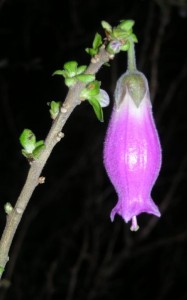Latua pubiflora is not to be missed. Possibly one of the choicest plants to come out of recent plant collecting expeditions to Chile. This introduction is from the joint University of Chile, RBGE expedition during 1998.
It was noted as an unprepossessing plant with yellow fruit found growing as a spiny shrub to 2.5m in alluvial gravel deposits on the eastern bank of the Rio Quihuis in the Los Lagos region of coastal mountains within Southern Chile. Growing at an altitude of 140 metres on a sparsely vegetated river bank.
Called “El Loco” as it is highly toxic when ingested, as is typical of many Solanaceae family members.
Staged opening of the flower buds occurs. These appear from the dormant growth buds and expand to 40mm into tubular corollas with a 5 pointed splayed end beyond which the extended stigma protrudes. The buds are encased by dark purple sepals which are forced open by the extending bright purple corolla tube. Hidden within are the 5 anthers held on filaments, the base of which are covered in fine white hairs.
Here in the nursery it reaches 4 metres as a very healthy strong growing deciduous shrub. As the girth of the main stem increases the bark splits revealing fissures, dark green and brown in colour. As previously mentioned it is spiny, these are prominent and extremely vicious spines. The growth can be managed by cutting back to ground level after flowering in April. This will give rise to the prolific production of watershoots from the pruning cuts. If this is done every six years the plant will remain manageable. Our plant, now ten years old has great vigour and a wide spreading head.
Young plants growing in a nursery bed can languish for several seasons then vigorous shoots will sprout from the base of the plant and reach 1.3 metres during the course of a single growing season. Could this be the hedging plant of the 21st century; reliably floriferous, barbed to repel, and responding positively to pruning cuts?
For a detailed description of Latua pubiflora read the article by Martin Gardner and Sabina Knees in The New Plantsman September 2000; Vol 7 Part three, pp.184 – 190.



Sistem Informasi
how long does the seeding process take?